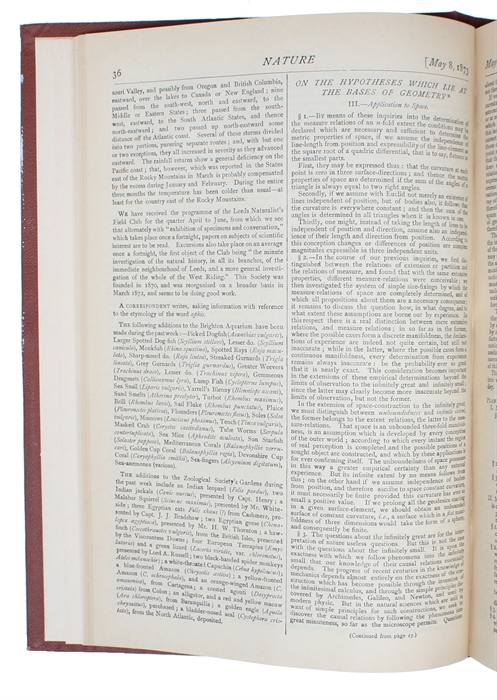RIEMANN, BERNHARD. - FOUNDING A NEW GEOMETRY.
On The Hypotheses which lie at the Bases of Geometry. (Translated by W.K. Clifford). (Ueber die Hypothesen, welche der Geometrie zu Grunde liegen).
London and New York, Macmillan and Co., 1873. 4to. Orig. full brown cloth, gilt spine, pictorial gilt frontcover. Near mint condition. Small embossed stamp at upper corner of title-page (David Dunlop ObservatoRy Library). In: "Nature, a weekly illustrated Journal of Science.", Volume VIII, May 1873 to October 1873. XII,562 pp. (Entire volume offered). Riemann's paper: pp. 14-17 a. 36-37. Internally clean and fine, no traces of use.
First English translation of this milestone work on the foundations of geometry. It "is one of the key work from which derives the modern study of differential geometry, and especially the study of manifolds of dimension greater than two. It was to prove central to the overthrow of Euclidean geometry as the source of geometrical ideas and to Einstein's general theory of relativity after 1915." (Grattan-Guiness "Landmark Writings in Western Mathematics 1640-1940).
It is a translation of Riemann's famous Habilitationsvortrag held in 1854 (in secondary literature, it is often misidentified as his Habilitationsschift, but that was concerned with Fourier series and was delivered the year before). Riemann begins his lecture with a remark about a certain darkness that lies at the foundation of geometry. This darkness obscures the relations between that which geometry assumes, i.e. the notion of space and the first principles of constructions in space. In Riemann's oponion one must take another approach towards this problem than the usual axiomatic method used ever since Euclid. The approach taken by Riemann is to a large extent guided by Gauss's work on the intrinsic geometry of surfaces; 'Disquisitiones generales circa superficies curvas', 1828. In this work Gauss showed that the curvature of a surface can be determined without reference to the ambient Euclidean space in which it lies, i.e. that the curvature is an intrinsic property of the surface. Based on this, Gauss showed several fundamental theorems about figures on the surface by referring only to the surface itself, i.e. indicating that the surface itself is a space with its own geometry, independent of the geometry of the ambient Euclidean space. Riemann argues that the true objects and properties of geometry are those which can be studied within the space itself, and he defines a general n-dimensional space in a similar manner to the parametric representation of a surface. Riemann believed that we know space only locally, he therefore bases his study of the geometry of such a general space (or manifold as they are known today) on the infinitesimal methods of calculus. This choice is a crucial departure from the classical axiomatic methods used by Euclid, Lobachevsky, and Bolyai. The notion of distance (or metric) on a manifold is a generalization of the usual Euclidean distance formula in n-dimensions. Particular choices of space and metric reveal both the hyperbolic geometries of Lobachevsky and Bolyai, and elliptic (or Riemannian) geometry. Riemann's approach to geometry is of paramount importance, this work "did more to change our ideas about geometry and physical space than any work on the subject since Euclid's Elements." (Landmark Writings in Western Mathematics, p.507). "The importance of this treatise is not confined to pure mathematics. Without it, Einstein would not have been able to develop his general theory of relativity." (Printing and the Mind of Man, p.177).
Order-nr.: 53254




